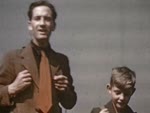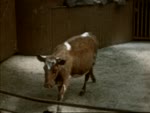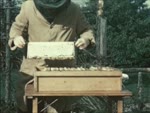BRACKEN MENACE, the
Full length video
Please read Understanding catalogue records for help interpreting this information and Using footage for more information about accessing this film.
Title: BRACKEN MENACE, the
Reference number: 6704
Date: 1939c
Production company: J.C. Elder
Sound: silent
Original format: 16mm
Colour: bw
Fiction: non-fiction
Running time: 20.36 mins
Description: West of Scotland Agricultural College study into combating bracken growth which hinders crofters by subsuming much of their land. The film demonstrates various methods used to curb the growth of bracken. Experiments are undertaken to keep it in check including chemical spraying, the taking of samples, scything and ploughing.
Shotlist: Credits (0.15) Throughout the Highlands there are many deserted crofts to be seen. (0.26) One of the factors which has made crofters desert these holdings has been the rapid encroachment of Bracken which is often the final blow to any hopes of wresting a living from the soil. (0.39) It ruins the land for grazing and renders it unsuitable for cultivation (0.47) cow in field surrounded by bracken (1.00) Cattle and other heavy animals can force their way through the bracken and in doing so damage it. Sheep seldom enter it except when attacked by the maggot fly. If not found there by the shepherd they die. Thus bracken greatly increases the difficulties in shepherding (1.16) sheep in bracken (1.30) To save loss of sheep, to simplify shepherding, and to improve grazing, farmers fight against the bracken plant, but a man scytheing about an acre a day makes slow progress. (1.42) man scything bracken (1.52) The West of Scotland Agricultural College has undertaken a campaign against bracken and with the help of farmers and crofters has made experiments on a wide variety of methods combating the bracken. (2.06) meeting in progress (2.20) The question "How does it spread so rapidly?" is answered by a study of the underground parts and a study of the soil to see what encourages its development. (2.30) bracken in field, pan down to roots (2.41) Examination was made of the "root" growth which was seen to reach down to the subsoil. (2.52) examination of root by 2 men (3.02) The underground stem --- more or less continuous, much branched and of great length --- spreads horizontally at a depth of as much as 2 feet in open soil but many be confined to a few inches over rock. (3.15) gvs roots (3.24) And when the turf was lifted the "roots" were seen to spread for considerable distances. They are packed with reserve food stores and throw up the new shoots. (3.39) men lifting turf, c/u roots (4.11) diagram showing bracken growth (4.44) What helps it to spread? What conditions favour it and check the grasses? is there a soil factor? (4.54) man taking soil sample (5.22) The soil is weighed, its moisture and acidity are ascertained, and analyses are made for chemical constituents. (5.34) int. laboratory, gvs women carry out soil analysis (6.35) How can we get rid of bracken? (1) Digging is difficult and expensive. (2) Poisoning is expensive and grass suffers also and may have to be replaced by sowing. (3) Destruction of the fronds by chemicals or cutting until underground reserves are exhausted is the most practical method. (6.56) Application of Sodium Chlorate at 2 -- 3 cwt. per acre is successful, but costly. (7.05) manual distribution (7.21) Spraying with solutions of Sulphuric Acid or Sodium chlorate over several seasons is cheaper but still too expensive. (7.33) manual spraying (7.42) Scythe cutting is expert work and costs from 2/6 --- 8 - per acre. A two headed scythe requires less skill to operate but is heavy work for the untrained. (7.56) two men with scythes (8.18) horse-drawn machines are quicker than the scythe and cheaper over large areas but in tall bracken it means hard work for the horse . These are :- (a) The Crossley and the Irvine Horse - attachment sever the fronds. (b) The Henderson The Holt The Glaslyn The Glaskyn Junior bruise but do not sever the fronds. One of them --- the Holt --- is shown at work. (8.51) gvs same, horse-drawn (9.14) leader (9.32) Motor machines can cut bracken areas more quickly at a lower cost per acre. These compromise :- The Allan The Atcoscythe The Collins Junior The One-wheel Collins The Collins Tractor "Mopper-up" The Gordon The Irvine. All of theses sever the fronds. (9.58) Here is a one-wheel Collins bracken cutter. It is driven by an air colled petrol engine and has a rotary wheel with hinged cutting blades. The hinges keep the blades from breaking when rocks are encountered. (10.14) gvs cutter in action (11.13) The Collins Junior Bracken Cutter --- the most successful machine --- is built on a similar principle. "Banks and braes" and boulders present no serious obstacles. (11.24) gvs bigger cutter in action (13.00) When 5 foot bracken is reduced to less than half this size a more speedy "Mopper-up" is wanted --- and has been produced. (13.13) attachment at rear of vehicle (13.33) How are the results of cutting measured? By :- (a) Total height. (b) Average number of fronds in random square foot or square yard samples. (c) Best of all, weight of fronds (all taken under similar conditions) from similar or larger sample plots. (13.52) After 1 years' cutting. (13.56) men measuring bracken, cutting and weighing (14.19) After 3 years' cuttings. (14.23) men measuring less bracken, cutting and weighing (14.45) After 5 years' cuttings. (14.50) men measuring even less bracken, cutting and weighing (15.17) Average results are shown by the following diagram, covering five cuttings. (15.26) diagram illustrating bracken growth (15.52) So by continued cutting it is possible to drive out the bracken. (16.05) A bracken cutting demonstration. (16.10) elevated pan large crowd (16.30) Inspection of machines. (16.32) gvs same (16.47) In action. (16.49) demonstration (17.29) The experimental croft at Burg Head --- on the wild west coast of Mull --- was a few years ago in danger of becoming derelict. But since it was taken over by the College, it has been transformed by scientific guidance aided by local experience and industry. (17.49) shot of Burg Head from boat (17.59) people ext. croft (18.04) Still worked on by the original tenant --- the third generation on the farm. (18.14) man hammering post (18.24) Crops of oats in an area which 2 years previously was covered with tall bracken --- cut in 1937 and 1938 --- then ploughed. The oat crop grown in 1939 was shoulder high. (18.39) pan area (18.55) adjacent hay crop on similar type of land. (19.01) 2 men stacking hay, no bracken (19.19) Bracken land where remnants of bracken still exist but so much reduced that it does nothamper grazing. Herding on such an area even with the larger flock that can now be carried is simple and mixed grazing of cattle and sheep helps to exclude the bracken. (19.37) gvs land, shepherd walks past, sheep and cattle (20.08) After a persistent and somewhat lengthy struggle the bracken is ousted from possession. Sheep and cattle browse together on verdant pastures. (20.21) gvs same (20.32) THE END (20.36)






